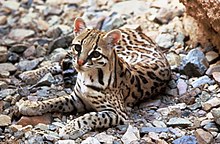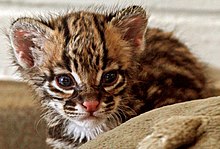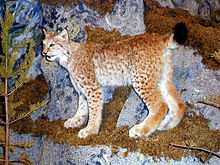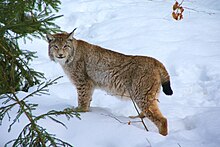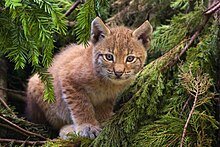Typically active during twilight and at night, the ocelot tends to be solitary and territorial. Ocelots are efficient at climbing, leaping and swimming. They prey on small terrestrial mammals, such as armadillos, opossums and rabbits. Both sexes become sexually mature at around two years of age; they can breed throughout the year, though the peak mating season may vary geographically. After a gestational period of two to three months, a litter of one to three is born. Offspring stay with their mother for up to two years, after which they leave to establish their own territories.
Ocelots prefer areas with dense vegetation cover, high prey availability, and proximity to water resources. Though classified as Least Concern on the IUCN Red List, the ocelot is threatened by factors such as habitat destruction, hunting and roadkill. Populations are decreasing in many parts of its range. The association of ocelots with humans dates back to the Aztec and Incan civilizations; like many other felids, ocelots have occasionally been owned as pets.
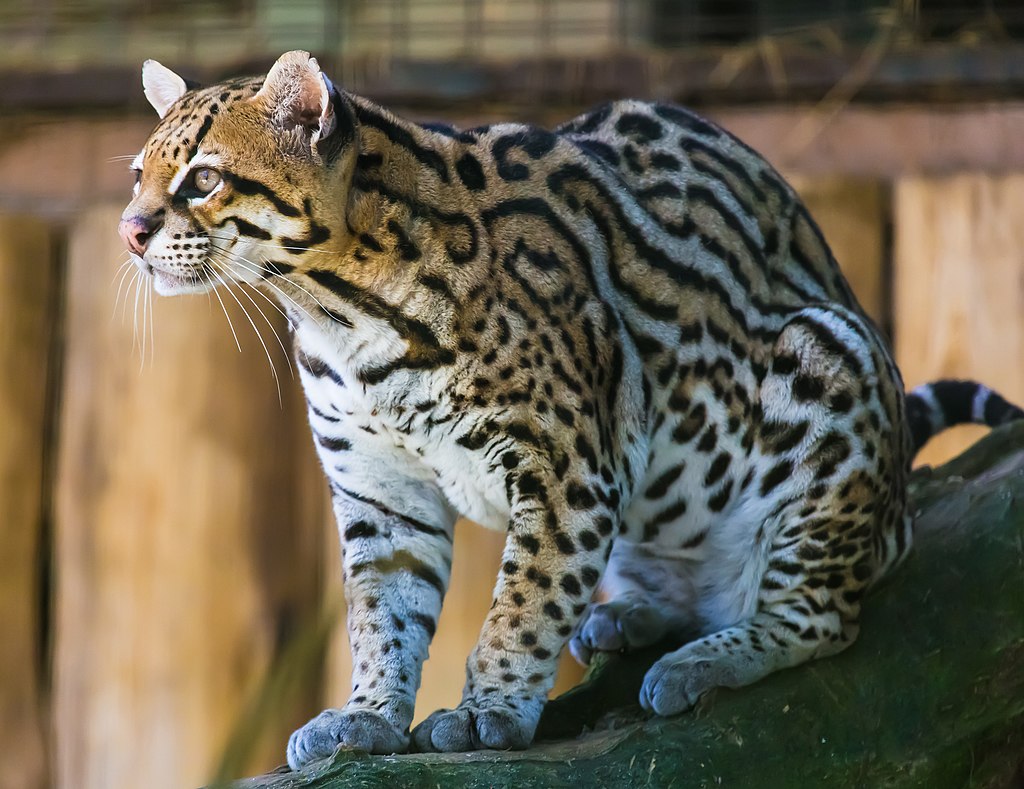
Etymology
The name "ocelot" comes from the Nahuatl word ōcēlōtl (pronounced [oːˈseːloːt͡ɬ]), which generally refers to the jaguar rather than the ocelot.[3][4][5] Another possible origin for the name is the Latin cellatus ("having little eyes" or "marked with eye-like spots"), in reference to the cat's spotted coat.[6]Other vernacular names for the ocelot include cunagaro (Venezuela), gato onza (Argentina), gato tigre (Panama), heitigrikati (Suriname), jaguatirica (Brazil), manigordo (Costa Rica, Panama and Venezuela), maracaja (Brazil), mathuntori, ocelote, onsa, pumillo, tiger cat (Belize), tigrecillo (Bolivia) and tigrillo (Colombia, Ecuador, Guatemala and Peru).[2][7]
Taxonomy
Felis pardalis was the scientific name proposed for the ocelot by Carl Linnaeus in 1758.[8] Eventually, zoologist Joel Asaph Allen, among others, placed the ocelot in the genus Leopardus (described by John Edward Gray in 1842).[9][10] Several ocelot specimens were described in the 19th and 20th centuries, including:[2][10]- Felis mitis by Frédéric Cuvier in 1824 was a specimen from Rio de Janeiro, Brazil.[11]
- F. chibi-gouazou by Edward Griffith in 1827 was based on earlier descriptions and illustrations.[12]
- Leopardus griseus by John Edward Gray in 1842 was a spotted cat skin from Central America in the collection of the Natural History Museum, London.[13]
- F. pseudopardalis by Pierre Boitard in 1845 was an ocelot kept in the Jardin des plantes.[14]
- F. melanura by Robert Ball in 1844 was a specimen from British Guiana.[15]
- F. albescens by Jacques Pucheran in 1855 was a specimen from Brownsville, Texas.[16]
- F. aequatorialis by Edgar Alexander Mearns in 1903 was a skin of an adult female ocelot from Talamanca canton in Costa Rica.[17]
- F. pardalis pusaea by Oldfield Thomas in 1914 was an ocelot skin and skull from Guayas Province in coastal Ecuador.[18]
- F. pardalis nelsoni and F. p. sonoriensis by Edward Alphonso Goldman in 1925 as subspecies of F. pardalis, based on specimens from Manzanillo and the Mayo River region respectively in Mexico.[19]
- L. pardalis steinbachi by Reginald Innes Pocock in 1941 was a specimen from Buena Vista, Ichilo in Bolivia.[20]
Subspecies
In 1998, a study of the mtDNA control region in ocelots distinguished four major groups throughout their range: Central America, northwestern South America, northeastern South America and southern South America south of the Amazon River.[21] A 2010 study of morphological features noted significant differences in the size and color of the Central and South American populations, suggesting they could be separate species.[22] In 2013, a study of craniometric variation and microsatellite diversity in ocelots throughout the range recognized three subspecies: L. p. albescens from the Texas–Mexico border, L. p. pardis from Central America and L. p. pseudopardalis from South America, though L. p. mitis may describe ocelots from the southern half of its South American range.[23]In 2017, the Cat Classification Task Force of the IUCN Cat Specialist Group noted that up to four subspecies can be identified from each of the two studies in 1998 and 2013, but given the disagreement in the geographical ranges suggested by these studies for the subspecies, only two of these could be recognized as valid. Not only are these two populations geographically separated by the Andes, they also differ in morphological features as noted in the 2010 study. These two subspecies are:[24]
- L. p. mitis (Cuvier, 1820): It occurs in South America as far south as northern Argentina. It is bigger and yellower than L. p. pardalis.
- L. p. pardalis (Linnaeus, 1758): Its range extends from Texas and Arizona southward to Costa Rica. It is smaller and grayer than L. p. mitis.
Phylogeny
Results of a phylogenetic study of the Felidae indicate that the ocelot diverged from the margay (Leopardus wieldii) between 2.41 and 1.01 mya. The Leopardus lineage is estimated to have diverged from the rest around 8 mya. The relationship of the ocelot within the Felidae is considered as follows:[25][26]
| |||||||||||||||||||||||||||||||||||||||||||||||||||||||||||||||||||||||||||||||||||||
Characteristics
Close view of an ocelot
It is a medium-sized cat with a head-and-body length of between 55 and 100 cm (21.7 and 39.4 in) and a 30 to 45 cm (11.8 to 17.7 in) long tail. The ocelot weighs between 5.0 and 7.3 kg (11 and 16 lb) and reaches 40–50 cm (16–20 in) at the shoulder. Males and females do not differ significantly in physical features; as such ocelots are not sexually dimorphic. Females weigh 6.6–11.3 kg (15–25 lb) and males 7–15.5 kg (15–34 lb).[6][30] Its footprint measures nearly 2 cm × 2 cm (0.8 in × 0.8 in).[31]
The ocelot can be easily confused with the margay and the oncilla, though ocelots are noticeably larger and heavier with shorter tails. Though all three have rosettes on their coats, the ocelot typically has a more blotched pattern; the oncilla has dark spots on its underbelly unlike the other two. Other differences lie in the facial markings, appearance of the tail and fur characteristics.[32][33][34] Ocelots are similar in size to bobcats, though larger individuals have occasionally been recorded.[35] The jaguar is notably larger and heavier, and has rosettes instead of spots and stripes.[36]
Habitat and distribution
Two ocelots, mother and daughter, in a wooded are of the Pantanal wetlands; at night, they encounter fewer humans on this farm.
According to the IUCN, the ocelot ranges from the southwestern United States to northern Argentina, and can occur up to an elevation of 3,000 m (9,800 ft).[1] The ocelot shares a large part of its range with the jaguar, jaguarundi, margay, oncilla and puma.[6]
Ecology and behavior
Ocelots rest on trees during the day.
The ocelot scent-marks its territory by spraying urine. The territories of males are 3.5–46 km2 (1.4–17.8 sq mi) large, while those of females cover 0.8–15 km2 (0.31–5.79 sq mi). Territories of females rarely overlap, whereas the territory of a male includes those of two to three females. Social interaction between sexes is minimal, though a few adults have been observed together even in non-mating periods, and some juveniles interact with their parents.[6] Data from camera trapping studies confirm that several ocelot individuals deposit scat in one or several communal sites, called latrines.[44][45][46] The ocelot can be aggressive in defending its territory, fighting even to death.[33]
The population density of ocelots has been observed to be high in areas with high rainfall, and tend to decrease with increasing latitude; highest densities have been recorded in the tropics.[47] In 2014, a study of ocelots in Barro Colorado Island gave a population density of 1.59–1.74/km2 (4.1–4.5/sq mi), greater than 0.984/km2 (2.55/sq mi) recorded in the northwestern Amazon in Peru in 2010, which was the densest ocelot population recorded thus far.[48][49]
Diet and hunting
Ocelots are carnivores, and are primarily active during twilight and at night.
Ocelots have been observed to follow scent trails to acquire prey. Ocelots may walk slowly at a speed of about 0.3 km/h (0.2 mph) searching for prey.[42] Alternatively, an ocelot may wait for prey for 30 to 60 minutes at a certain site, and move to another walking at 0.8–1.4 km/h (0.5–0.9 mph) if unsuccessful. They tend to eat the kill immediately, and remove feathers before eating birds. An ocelot typically prefers hunting in areas with vegetation cover, avoiding open areas, especially on moonlit nights, so as not to be seen by the prey.[6]
Reproduction
An ocelot kitten
A litter of one to three is born after a gestational period of two to three months. Females give birth in dens, usually located in dense vegetation. A newborn kitten weighs 200–340 g (7.1–12.0 oz).[6][30] The kitten is born with spots and stripes, though on a gray background; the color changes to golden as the ocelot grows older.[28] A study in southern Texas revealed that a mother keeps a litter in a den for 13 to 64 days, and shifts the young to two or three dens.[57] The kitten's eyes open 15 to 18 days after birth. Kittens begin to leave the den at the age of three months. They remain with their mother for up to two years, and then start dispersing and establishing their own territory. In comparison to other felids, ocelots have a relatively longer duration between births and a narrow litter size. Captive ocelots live for up to 20 years.[6]
Conservation status
The IUCN classifies the ocelot as Least Concern, given its significant occurrence in Brazil, totaling to more than 40,000 individuals including the populations in the rest of the range according to a 2013 study.[1][58] However, the numbers are decreasing in many areas of the range due to several threats, including habitat destruction due to human settlement, poaching, roadkills and pollution.[1]Studies have recorded ocelots in oil palm landscapes and big cattle ranches in the Colombian llanos and inter-Andean valleys.[59] A 2012 study estimated 1,500 to 8,000 ocelots in Argentina throughout all the subtropical regions.[60] In Texas and northeastern Mexico, ocelot populations have reduced drastically; as of 2014, the population in Texas is estimated to be 50–80 individuals. The reduced numbers have led to increased inbreeding and low genetic diversity.[1][61]
Ocelot hunting has been banned in Argentina, Brazil, Bolivia, Colombia, Costa Rica, French Guiana, Guatemala, Honduras, Mexico, Nicaragua, Panama, Paraguay, Suriname, Trinidad and Tobago, United States, Uruguay and Venezuela; regulations have been placed on hunting in Peru.[1] The US Fish and Wildlife Service, the Texas Parks and Wildlife Department and The Nature Conservancy are among agencies actively involved in ocelot conservation efforts, such as the protection and regeneration of vegetation in the Rio Grande Valley.[62][6]
Threats
Spotted fur trade was a flourishing business in the 1960s and the 1970s that resulted in severe exploitation of felids such as the ocelot and the jaguar. [63] For instance in the 1960s, ocelot skins were among the most highly preferred in the US, reaching an all-time high of 140,000 skins in 1970.[64] This was followed by prohibitions on commercial trade of spotted cat skins in several range states such as Brazil and the US, causing ocelot skins in trade to plummet.[63][65] In 1986, the European Economic Community banned ocelot skin import, and, in 1989, the ocelot was included in Appendix I of CITES. However, hunting of ocelots for skins has continued and is still a major threat to ocelot survival.[6]Moreover, the fertile land that supports dense cover and constitutes the optimum habitat for ocelots is being lost to agriculture. The habitat is often fragmented into small pockets that cannot support ocelots well, leading to deaths due to starvation. Roadkills have emerged as a major threat over the years as ocelots try to expand beyond their natural habitat into new areas and get hit by vehicles.[62]
Another threat has been the international pet trade; this typically involves capturing ocelot kittens by killing their mothers; these cats are then sold to tourists. Though it is banned in several countries, pet trade survives; in some areas of Central and South America ocelots are still sold in a few local markets.[66][67]
In culture
Moche ceramic bottle in the shape of an ocelot, Musée d'ethnographie de Genève, Switzerland
"According to the well-known myth, Tezcatlipoca, when cast down from heaven by Quetzalcoatl, "fell into the water where he transformed himself into an ocelot" and arose to kill certain giants.
At the back of his head, above his left hand, the head of an ocelot is visible, whose skin hangs behind his back, the tail ending below his knee. Besides this the personage wears leggings made of the spotted ocelot skin and a rattlesnake girdle from which hang two conventionalized hearts. It is interesting to find that in a note written beneath its photograph the late Senor Islas de Bustamante, independently identified the above figure as a representation of "Ocelotl-Tezcatlipoca" or Tlatoca-ocelot, lit. the Lord Ocelot ... and described as wearing "the beard of the mask of Tezcatlipoca".Like many other felids, ocelots are occasionally kept as pets. Mindy Stinner (of the Conservators Center, Burlington) notes that ocelots, unlike caracals and servals, might demand a lot of attention from their owners. They have a tendency to chew on or suck on objects, such as fabric and the fingers of their owners; this can lead them to accidentally ingest objects like tennis balls. Agile and playful, pet ocelots can be troublesome to keep due to their habit of leaping around and potentially damaging objects; ocelots may unintentionally injure their owners from bites. Nevertheless, carefully raised ocelots can be highly affectionate to their owners.[69] Painter Salvador Dalí owned a pet ocelot named Babou that was seen with him at many places he visited, including a voyage aboard SS France. When one of the diners at a Manhattan restaurant was alarmed by the ocelot, that Dali had brought along with him to the place, he told her that it was a normal cat that he had “painted over in an op art design”.[70][71][72][73] Opera singer Lily Pons and musician Gram Parsons are also known to have owned ocelots.[74][71]
- L. p. mitis Cuvier, 1820
- L. p. pardalis Linnaeus, 1758
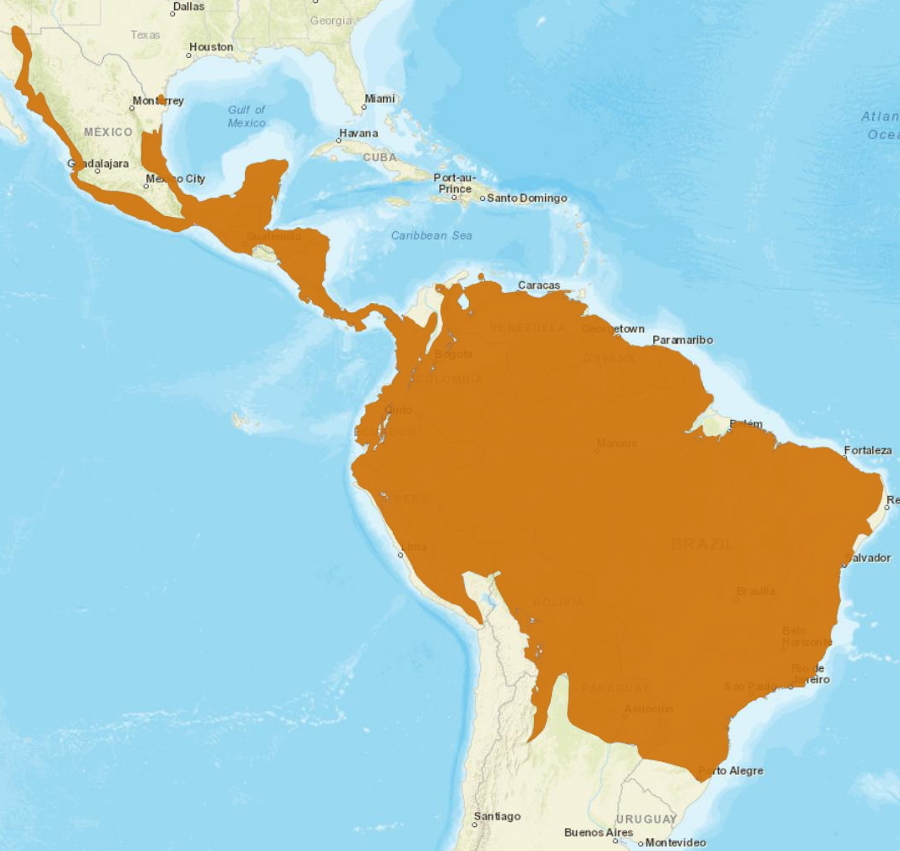
Distribution of the ocelot
